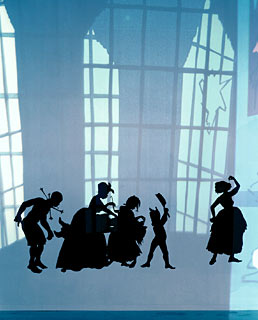|
 |
 |


|

Insurrection! (Our Tools Were Rudimentary, Yet We Pressed On), 2000 (detail). Cut paper silhouettes and light projections, site-specific dimensions. Purchased with funds contributed by the International Director's Council and Executive Committee
Members. 2000.68. Photo: Ellen Labenski.
|
 |
Kara Walker arranges life-sized silhouetted figures into raucous tableaux that recount the brutal, and often repressed, history of American race relations. Her unique use of the paper cut-out technique derives from the old craft of silhouetting. The artist likens this representational method to the nature of stereotypes themselves, in which the complexities of individual identities, situations, and personalities are simplified and distorted into easily readable, caricatured forms. Walker derives her imagery from the visual language of the antebellum South and from the tradition of the minstrel show and redeploys them to subversive ends. Performed by white actors in blackface, the minstrel theater parodied the lives of African Americans and allowed whites to vicariously break their own cultural taboos by portraying unbridled sexuality, unstructured time, and puerile behavior. In her work, Walker inverts the roles of these characters. Her stylized figures enact the violence that attends oppression and embodies scenes of bestiality, castration, murder, and cannibalism.
In Insurrection! (Our Tools Were Rudimentary, Yet We Pressed On) (2000), a series of grisly scenes unfold. A plantation owner propositions a naked slave behind a tree and a woman with a tiny baby on her head escapes a lynching, while a group of people eagerly torture a victim. In this piece, Walker expands the vocabulary of her shadowy forms to include projected silhouettes and colored lights. When viewers walk in front of these projections, their shadows are introduced into the scene, denying them the comfortable position of spectator and implicating them in the unfolding events.
|
|















